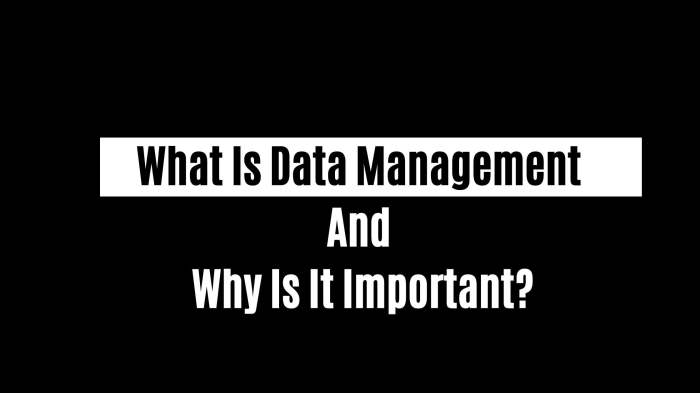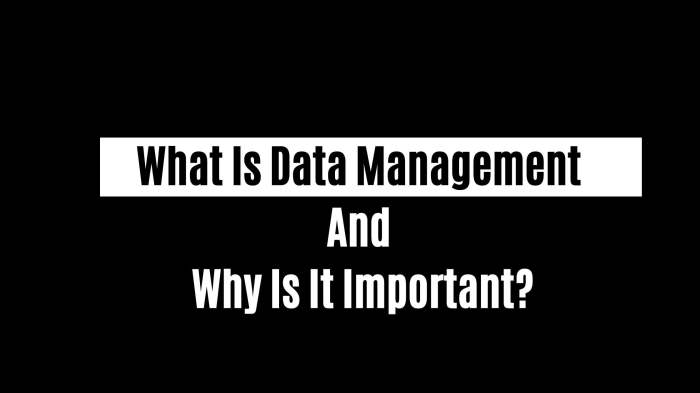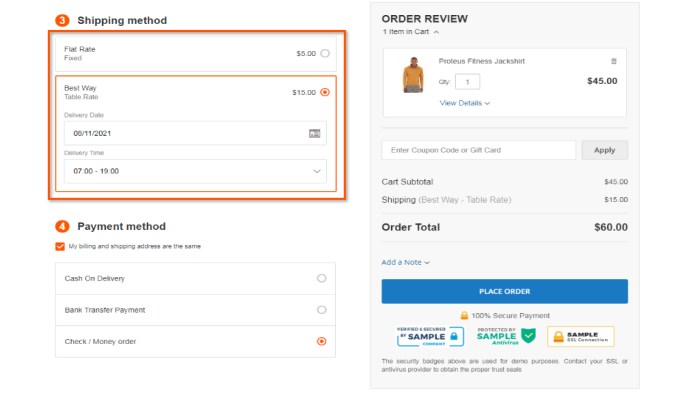Why is data management important to your business? This crucial question delves into the heart of modern business success. From boosting decision-making to optimizing operations and fostering customer relationships, effective data management is no longer a luxury, but a necessity.
Data integrity, accurate and reliable information, is fundamental to every business function. Without it, decisions are shaky, and operations become inefficient. This comprehensive guide explores the vital role of data management in various facets of your business, from enhancing operational efficiency to bolstering customer relationships and driving innovation. We’ll also touch on the crucial aspects of data security and compliance.
Importance of Data Integrity

Accurate and reliable data is the bedrock of any successful business. It underpins informed decision-making, strategic planning, and ultimately, profitability. Without trustworthy data, businesses risk making flawed assumptions, pursuing ineffective strategies, and falling behind competitors. This section dives deep into the critical role of data integrity in maintaining operational efficiency and achieving business goals.Data integrity is more than just having data; it’s about having data that is accurate, consistent, and reliable.
This means that the data reflects reality and can be trusted for use in various business processes. Inaccurate data can lead to costly errors and flawed insights, impacting everything from marketing campaigns to financial reporting. Understanding the importance of data integrity and implementing robust validation procedures are essential for any organization looking to leverage its data effectively.
Impact of Inaccurate Data on Decision-Making
Inaccurate data can lead to significant miscalculations and flawed insights. For example, an inaccurate sales forecast could result in overstocking or understocking of inventory, leading to lost revenue or wasted resources. A miscalculation of customer demographics could lead to ineffective marketing campaigns that fail to resonate with the target audience. Financial reporting with incorrect data can result in misjudged performance and potential financial penalties.
Consequently, the foundation of sound decision-making is reliant on the quality of the data used.
Data Validation and Verification Procedures
Implementing a system for data validation and verification is crucial to maintain data integrity. This process should encompass several stages:
- Data Entry Validation: This involves setting up rules and constraints during data entry to ensure that the data conforms to predetermined formats, ranges, and values. For instance, a date field should only accept valid dates, and a numerical field should only accept numbers within a specific range. This prevents erroneous data from being entered in the first place.
- Data Consistency Checks: These checks ensure that related data elements are consistent. For instance, if a customer’s address changes, all related records should be updated accordingly. This avoids discrepancies and maintains the accuracy of the data.
- Data Verification: This stage involves independent review of the data by another person to validate its accuracy. This is crucial for catching errors missed in initial validation steps.
- Regular Data Audits: Periodic data audits are essential to identify and rectify inconsistencies or errors that may have crept in over time. This involves checking for data integrity, identifying anomalies, and correcting inaccuracies.
Maintaining Data Consistency and Preventing Data Corruption
Data consistency and prevention of corruption are crucial for the long-term reliability of business data. To maintain consistency, regular backups and data recovery plans are vital. This ensures that if data is lost or corrupted, it can be easily restored from a backup.
- Data Backup and Recovery Procedures: Implementing regular data backups, using appropriate encryption methods, and establishing a recovery plan in case of a disaster is paramount. A backup plan should involve multiple copies of data, stored in different locations, to prevent data loss due to system failure, hardware issues, or other unforeseen circumstances.
- Data Security Measures: Protecting data from unauthorized access, modification, or destruction is crucial. Robust security measures such as access controls, encryption, and intrusion detection systems can prevent data breaches and maintain data integrity.
- Data Governance Policies: Establishing clear data governance policies helps define roles, responsibilities, and procedures for data management. This includes defining who can access and modify data and under what conditions.
Data Integrity Policies and Implications
Different data integrity policies have varying implications for a business. A table below summarizes common policies and their impacts:
| Data Integrity Policy | Description | Implications for Business |
|---|---|---|
| Accuracy | Ensuring data reflects reality. | Improved decision-making, reduced errors, increased efficiency. |
| Completeness | Ensuring all necessary data is present. | Comprehensive insights, avoidance of missing data issues, better forecasting. |
| Consistency | Maintaining uniformity across data elements. | Reduced discrepancies, improved data reliability, consistent reporting. |
| Timeliness | Ensuring data is updated regularly. | Up-to-date insights, improved responsiveness, better decision-making. |
Data Management for Improved Decision-Making

Effective data management is crucial for any business seeking to thrive in today’s data-driven world. By establishing robust processes for collecting, storing, and analyzing information, organizations can gain valuable insights, identify emerging trends, and make more informed decisions, ultimately leading to increased profitability and sustainable growth. A well-managed data infrastructure is the bedrock upon which informed strategies are built.Data management, when executed effectively, transforms raw data into actionable intelligence.
This intelligence allows businesses to understand customer preferences, predict market fluctuations, and optimize operational processes. The result is a more agile and responsive organization, better positioned to seize opportunities and mitigate risks. Data-driven decisions are not just about making choices; they are about making the
right* choices.
Data Analysis and Trend Identification
Data analysis plays a pivotal role in transforming raw data into meaningful insights. Sophisticated analytical techniques, ranging from simple descriptive statistics to complex machine learning algorithms, enable businesses to uncover hidden patterns and trends within their data. These patterns can reveal customer preferences, predict future demand, and pinpoint areas for process improvement. The key is to not just collect data, but to actively seek out and understand the stories hidden within it.
Data-Driven Decisions and Profitability
Data-driven decisions have a direct impact on profitability. For example, a retail company analyzing sales data might discover a seasonal trend in certain product categories. This insight allows them to proactively adjust inventory levels, optimize marketing campaigns, and potentially increase sales during peak seasons. By leveraging data, businesses can make strategic decisions that maximize return on investment and minimize risk.
Analytical Approaches to Business Data
Various analytical approaches are available to businesses, each with its strengths and weaknesses. Descriptive analytics focuses on summarizing past data to understand what has happened. Predictive analytics uses historical data to forecast future outcomes. Prescriptive analytics goes a step further, suggesting actions to optimize future results. The choice of approach depends on the specific business question being addressed and the available data.
| Analytical Approach | Focus | Example |
|---|---|---|
| Descriptive | Summarizing past data | Sales figures for the last quarter |
| Predictive | Forecasting future outcomes | Predicting future demand for a product based on historical sales data |
| Prescriptive | Suggesting actions to optimize future results | Recommending pricing strategies to maximize profits |
Data Visualization Tools
Data visualization tools are invaluable for communicating complex insights in a clear and concise manner. These tools transform data into charts, graphs, and other visual representations, enabling stakeholders to quickly grasp key trends and patterns. Visualization tools not only enhance understanding but also foster collaboration and facilitate informed decision-making across the organization. Visualizations make it easier to identify anomalies, correlations, and other meaningful information within the data.
For instance, a line graph showcasing sales figures over time can easily highlight seasonal trends or sudden drops in sales. This kind of clear visualization allows for quick and easy interpretation of the data.
Data Management and Operational Efficiency
Effective data management isn’t just about storing information; it’s a cornerstone of operational efficiency. Organized data empowers businesses to streamline processes, reduce costs, and make faster, more informed decisions. By understanding how data flows within your organization and optimizing access, you can unlock significant improvements in productivity and profitability.Data, when properly managed, acts as a crucial engine for operational efficiency.
It allows businesses to track key performance indicators (KPIs) in real-time, identify bottlenecks, and implement corrective actions swiftly. This proactive approach to managing information significantly impacts the bottom line.
Streamlined Processes Through Data Organization
Properly structured data allows for more efficient workflows. Clear data definitions and standardized formats eliminate ambiguity and inconsistencies, reducing errors and wasted time. Automated processes can be implemented when data is readily accessible and structured in a logical manner. For example, a manufacturing company with organized inventory data can automatically trigger reorder points, minimizing stockouts and preventing production delays.
Reduced Operational Costs Through Data Management
Data management can significantly reduce operational costs in several ways. By minimizing errors, streamlining processes, and optimizing resource allocation, businesses can save money across departments. For instance, a retail company can use data analysis to identify slow-moving inventory and adjust pricing or marketing strategies to improve sales, reducing storage costs and losses. Accurate data about customer behavior can also guide targeted marketing campaigns, improving ROI and reducing wasted marketing spend.
Optimizing Data Access and Retrieval
Efficient data access and retrieval are essential for operational efficiency. Implementing robust data warehousing solutions and utilizing advanced search capabilities can significantly reduce the time required to locate and utilize critical information. Employing data retrieval tools that can sort, filter, and aggregate data based on specific criteria will speed up the decision-making process. A well-designed database schema with optimized indexes and appropriate data partitioning will accelerate query performance and data retrieval times.
Data Flow in a Business Process: A Flowchart Example
The following flowchart illustrates a simplified example of how data flows through a sales process:
Note: This is a generic example. Actual data flow will vary based on specific business processes.
Solid data management is crucial for any business. It helps you understand your customers better, track campaign performance, and make informed decisions. To really maximize your online presence, you need to find the right way to outsource online marketing, like the right way to outsource online marketing. This will free up your internal resources to focus on the data analysis and strategic planning that ultimately drive growth.
Data is the key, after all.
+-----------------+ +-----------------+ +-----------------+
| Customer Inquiry | --> | Sales Order Entry | --> | Inventory Update |
+-----------------+ +-----------------+ +-----------------+
| (Data Input) | | (Data Input) | | (Data Output) |
+-----------------+ +-----------------+ +-----------------+
| |
V V
+-----------------+ +-----------------+
| Order Fulfillment| <-- | Sales Order Data |
+-----------------+ +-----------------+
| (Data Output) | | (Data Input) |
+-----------------+ +-----------------+
| |
V V
+-----------------+
| Customer Invoice |
+-----------------+
| (Data Output) |
+-----------------+
This example demonstrates how data moves from customer interactions to order fulfillment and ultimately to invoicing.
Each step in the process relies on the integrity and accessibility of the data from the previous step. Data management is crucial to ensure smooth data flow.
Methods for Optimizing Data Access and Retrieval Times
- Data Indexing: Creating indexes on frequently queried data columns significantly accelerates data retrieval speed. Indexes are like a table of contents in a book, enabling the database to quickly locate relevant data rows.
- Data Partitioning: Dividing large datasets into smaller, manageable partitions allows for more targeted queries and faster retrieval times. Imagine a massive library; partitioning allows you to locate a specific book more quickly.
- Data Caching: Caching frequently accessed data in memory drastically reduces the time required to retrieve it. This approach is like having frequently used items on your desk rather than searching through a filing cabinet each time.
- Query Optimization: Analyzing and refining database queries can significantly improve retrieval speed. This involves using efficient query structures and minimizing unnecessary operations.
Data Management and Customer Relationship Management (CRM)
Data management plays a crucial role in nurturing strong customer relationships. A well-structured data management system empowers businesses to understand their customers deeply, personalize interactions, and ultimately drive customer loyalty and revenue growth. By organizing and analyzing customer data, companies can gain valuable insights that improve customer service, tailor marketing efforts, and create a more positive customer experience.
How Data Management Supports Better Customer Understanding
Data management systems provide a centralized repository for customer data, encompassing demographics, purchase history, interaction logs, and feedback. This consolidated view allows businesses to paint a comprehensive picture of each customer, moving beyond basic profiles to a nuanced understanding of individual needs, preferences, and behaviors. By connecting various data points, companies can uncover hidden patterns and trends that reveal valuable insights into customer motivations and purchasing decisions.
This in-depth understanding is essential for developing targeted strategies and delivering personalized experiences.
Examples of How Data Analysis Improves Customer Service
Data analysis can significantly enhance customer service. For example, by analyzing customer service call logs and feedback, companies can identify recurring issues and areas for improvement. This allows for proactive solutions to common problems, leading to faster resolution times and happier customers. Analyzing purchase history and interaction data can also help anticipate customer needs, enabling proactive customer support and personalized recommendations.
Real-time data analysis can also identify at-risk customers and allow for intervention to prevent churn or dissatisfaction.
Strategies for Segmenting Customers Based on Data Analysis
Customer segmentation is a critical aspect of targeted marketing. Data analysis provides the tools to divide customers into distinct groups based on shared characteristics, behaviors, and preferences. For instance, companies can segment customers by purchase frequency, product preferences, or engagement levels with marketing materials. This granular segmentation enables businesses to tailor marketing messages and product offerings to resonate more effectively with specific customer groups, resulting in higher conversion rates and increased customer lifetime value.
Segmenting customers based on location and buying habits is another powerful way to improve campaign effectiveness.
The Role of Data in Personalizing Customer Experiences
Personalization is key to building strong customer relationships. Data management systems allow businesses to gather and analyze customer data to create customized experiences. This includes tailoring product recommendations, sending targeted promotions, and offering personalized support. For instance, online retailers can use browsing history and purchase patterns to recommend relevant products to individual customers. Personalized experiences foster a stronger connection between the customer and the brand, leading to increased loyalty and advocacy.
Benefits of Using Customer Data for Targeted Marketing Campaigns
| Benefit | Description |
|---|---|
| Increased Conversion Rates | Targeted campaigns resonate better with specific customer segments, leading to higher conversion rates. |
| Improved ROI | More effective campaigns yield a higher return on investment by maximizing the impact of marketing efforts. |
| Reduced Marketing Costs | By focusing resources on the most receptive customer segments, businesses can optimize marketing budgets. |
| Enhanced Customer Engagement | Personalized interactions foster stronger customer engagement and loyalty. |
| Improved Brand Perception | Delivering relevant and valuable content to specific customer segments enhances the brand’s image and perception. |
Data Security and Compliance: Why Is Data Management Important To Your Business
Data security is no longer a luxury, but a fundamental necessity for any modern business. In today’s interconnected world, sensitive information is constantly at risk from cyber threats. Protecting this data is crucial for maintaining trust with customers, employees, and partners, and for avoiding costly and reputation-damaging breaches. A robust data security strategy is a key component of overall business resilience.Maintaining the integrity and confidentiality of data is essential for the long-term health and success of any organization.
Failure to address security vulnerabilities can lead to significant financial losses, legal repercussions, and irreparable damage to a company’s reputation. Proactive measures are paramount to prevent these risks.
Strong data management is crucial for any business’s success, especially when dealing with the ever-evolving digital landscape. Proper organization and accessibility of information are key for informed decision-making. Understanding how search engines like Google operate, such as the complex workings of the Google BERT algorithm what is google bert algorithm , is also essential. Ultimately, meticulous data management ensures your business remains competitive and adaptable in today’s dynamic market.
Importance of Data Encryption
Data encryption is a cornerstone of modern data security. It renders sensitive data unreadable to unauthorized individuals by converting it into an encoded format. This process ensures that even if data is intercepted, it remains incomprehensible without the proper decryption key. Robust encryption techniques protect against various types of threats, including data breaches, malware attacks, and unauthorized access.
Best Practices for Protecting Sensitive Data
Implementing a comprehensive data security strategy requires a multi-faceted approach. A robust security framework involves a variety of practices that address different facets of data protection.
- Strong Passwords and Multi-Factor Authentication (MFA): Implementing strong password policies and MFA is critical for protecting accounts and preventing unauthorized access. This involves enforcing password complexity requirements, regular password changes, and educating employees on the importance of strong passwords. MFA adds an extra layer of security by requiring more than one form of verification to access sensitive information.
- Regular Security Audits and Vulnerability Assessments: Regular security audits and vulnerability assessments are crucial to identify and address potential security weaknesses. This process involves examining the security infrastructure for vulnerabilities and weaknesses, and developing strategies to mitigate these risks. Proactive identification of weaknesses prevents potential breaches before they occur.
- Data Loss Prevention (DLP) Systems: Implementing DLP systems can prevent sensitive data from leaving the organization’s control. These systems monitor data flow and prevent sensitive information from being transmitted to unauthorized recipients or stored in unprotected locations. This prevents accidental data leaks and malicious exfiltration.
Impact of Data Breaches
Data breaches have far-reaching consequences that extend beyond the immediate technical issues. A data breach can severely damage a company’s reputation, erode customer trust, and result in substantial financial losses. The negative impact of a breach often involves significant costs associated with incident response, legal fees, and reputational damage. Rebuilding trust after a breach can take considerable time and resources.
Relevant Data Protection Regulations and Standards
Numerous data protection regulations and standards exist to safeguard sensitive data. Adherence to these regulations is essential to avoid legal penalties and maintain compliance. These standards and regulations offer guidelines for organizations to manage and protect data, including identifying and controlling access, usage, and retention of personal data.
- General Data Protection Regulation (GDPR): GDPR is a comprehensive data protection regulation that sets strict rules for handling personal data within the European Union. It imposes stringent obligations on organizations regarding data collection, storage, and processing.
- California Consumer Privacy Act (CCPA): The CCPA grants California consumers greater control over their personal information. It provides specific rights regarding access, deletion, and correction of personal data.
Data Encryption Techniques
Various data encryption techniques are available, each with its own strengths and weaknesses. Choosing the appropriate technique depends on the sensitivity of the data and the specific security needs.
- Symmetric-key encryption: Uses the same key for encryption and decryption, which can be more efficient for large datasets. Examples include AES (Advanced Encryption Standard) and DES (Data Encryption Standard).
- Asymmetric-key encryption: Uses separate keys for encryption and decryption, which is commonly used for secure communication. Examples include RSA (Rivest–Shamir–Adleman) and ECC (Elliptic Curve Cryptography).
- Hashing: Creates a unique fingerprint of data, commonly used for data integrity checks. Examples include MD5 and SHA-256.
Data Management and Innovation
Data management is no longer just about storing and retrieving information; it’s a catalyst for innovation. A well-structured data ecosystem empowers businesses to glean insights, identify emerging trends, and develop creative solutions, ultimately fostering a competitive edge. By understanding and leveraging the power of data, companies can transform their operations and unlock new avenues for growth.Effective data management isn’t just about the tools and technology; it’s about cultivating a culture of data-driven decision-making across the entire organization.
This includes establishing clear data governance policies, empowering employees with data literacy skills, and fostering a collaborative environment where data is shared and leveraged for problem-solving.
The Link Between Data Management and Business Innovation
Data management forms the bedrock for innovation. By providing a reliable and accessible source of information, businesses can identify patterns, predict future trends, and develop innovative products and services. Data insights allow for a deeper understanding of customer needs and preferences, leading to more targeted and effective solutions. This, in turn, drives increased efficiency and productivity, ultimately contributing to the bottom line.
Strong data management is crucial for any business’s success. Understanding your key performance indicators (KPIs) is vital, and knowing the difference between, say, a counter metric and a north star metric, is key to effective decision-making. For example, mastering the nuances of these different metrics, like counter metric vs north star metric understanding the difference , allows you to focus on the truly impactful data points that drive your business forward.
Ultimately, good data management empowers strategic choices and fuels sustainable growth.
Examples of Data Analysis in Product Development
Data analysis can be instrumental in developing new products and services. For instance, analyzing customer purchase history can reveal unmet needs and preferences, which can inform the development of new product features or entirely new product lines. A clothing retailer, for example, might use sales data to identify a growing demand for sustainable fabrics. This insight could drive the development of new lines of eco-friendly clothing.
Similarly, analyzing user behavior on a website can reveal areas where the user experience could be improved, potentially leading to a more user-friendly interface.
How Data Insights Fuel Creative Problem-Solving
Data insights can fuel creative problem-solving by revealing hidden patterns and correlations that might not be apparent through traditional methods. Consider a company facing declining sales. Data analysis might reveal a correlation between declining sales and a particular marketing campaign. This insight could lead to a re-evaluation of the campaign strategy, leading to more effective marketing efforts and potentially revitalizing sales.
The analysis could also highlight unexpected factors that were previously overlooked, fostering a fresh approach to problem-solving.
Different Approaches to Data-Driven Innovation
Different approaches to leveraging data for innovation exist. One approach involves using data to identify unmet customer needs and develop products or services that directly address those needs. Another approach is using data to improve existing products or services, making them more efficient, effective, or user-friendly. A third approach focuses on creating entirely new business models by leveraging data insights to identify new market opportunities.
Each approach requires a different set of skills and tools.
Identifying Emerging Market Trends with Data Analysis, Why is data management important to your business
Data analysis can effectively identify emerging market trends. By tracking consumer behavior, social media conversations, and market indicators, companies can gain valuable insights into shifts in consumer preferences and emerging demands. For instance, a food company might use data to observe an increasing interest in plant-based diets and adjust their product offerings accordingly, leading to the development of new, healthier, and more sustainable food options.
Analyzing sales data and market research reports can reveal emerging trends, providing valuable insights into potential future demands and opportunities.
Data Management for Scalability and Growth
A robust data management system isn’t just about organizing information; it’s a cornerstone for sustainable business growth. As companies expand, their data volumes and complexity increase exponentially. A well-structured system ensures that this data remains usable, accessible, and reliable, enabling informed decisions and efficient operations, even as the business scales. This crucial aspect of data management allows companies to adapt to changing demands and maintain a competitive edge.Effective data management anticipates future growth, making expansion plans smoother and more predictable.
By laying a strong foundation now, businesses can avoid costly and time-consuming rework later when faced with rapid scaling. This proactive approach ensures that data remains the lifeblood of the business, enabling rapid adaptation and decision-making as the company evolves.
Data Management Systems and Future Expansion Plans
Data management systems are critical for future expansion plans. A well-designed system can support different expansion strategies. For example, a company planning to enter new markets can leverage historical data to understand customer preferences in those markets, anticipate demand fluctuations, and tailor product offerings. Similarly, if a company intends to acquire other businesses, a robust data management system will allow for seamless integration of the acquired company’s data.
This allows for a more thorough understanding of the combined entity, facilitating informed decisions and preventing data silos.
Strategies for Adapting Data Management Systems to Evolving Business Needs
Adapting data management systems to evolving business needs is essential for long-term success. Flexibility and scalability are key considerations. A rigid system will hinder growth and innovation. One strategy is to choose a cloud-based platform that allows for easy scaling. Another approach involves implementing data governance policies that promote data quality and standardization.
This helps maintain data integrity as the business expands and incorporates new data sources.
Data Management and Increasing Data Volumes
Managing increasing data volumes requires a sophisticated approach. Companies should invest in technologies that can efficiently store, process, and analyze large datasets. This often involves implementing data warehousing or data lakes solutions, and potentially employing big data analytics tools. A good example is Amazon. Their massive online retail operation is supported by a sophisticated data management system that can handle an enormous volume of transaction data, customer information, and product details.
This enables them to offer personalized recommendations, optimize inventory management, and make informed business decisions.
Ensuring Data Integrity as the Business Scales
Maintaining data integrity is paramount as the business scales. Data governance policies, which define data ownership, access controls, and quality standards, are essential. Implementing automated data validation checks can catch errors early in the process. A data quality management tool can continuously monitor data quality, flagging inconsistencies and inaccuracies. This ensures the reliability of data and prevents inaccuracies from negatively impacting decisions and operations.
For example, a manufacturing company that needs to scale its production will require accurate data on inventory levels, production capacity, and supply chain details. Ensuring the integrity of this data will prevent operational bottlenecks and ensure smooth scaling.
Final Thoughts
In conclusion, a robust data management strategy is the bedrock of a thriving business. It’s not just about storing information; it’s about leveraging data to gain crucial insights, improve decision-making, streamline operations, nurture customer relationships, and fuel innovation. By prioritizing data management, businesses can unlock significant advantages and achieve sustainable growth in today’s data-driven world.






